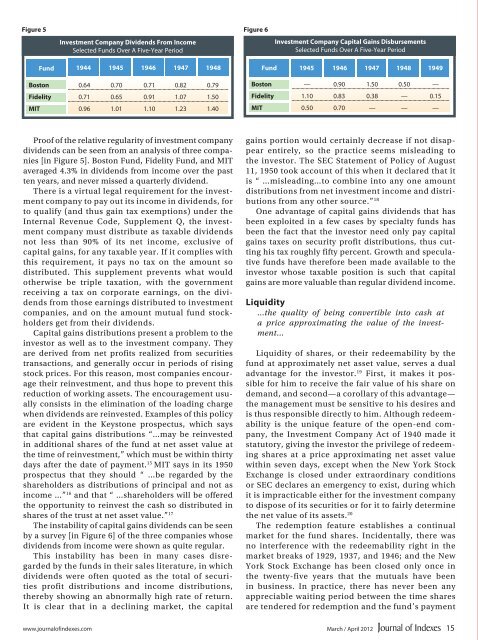Create successful ePaper yourself
Turn your PDF publications into a flip-book with our unique Google optimized e-Paper software.
Figure 5<br />
Figure 6<br />
Investment Company Dividends From In<strong>com</strong>e<br />
Selected Funds Over A Five-Year Period<br />
Investment Company Capital Gains Disbursements<br />
Selected Funds Over A Five-Year Period<br />
Fund<br />
1944 1945 1946 1947<br />
1948<br />
Fund<br />
1945 1946 1947 1948 1949<br />
Boston 0.64 0.70 0.71 0.82 0.79<br />
Fidelity 0.71 0.65 0.91 1.07 1.50<br />
MIT 0.96 1.01 1.10 1.23 1.40<br />
Boston — 0.90 1.50 0.50 —<br />
Fidelity 1.10 0.83 0.38 — 0.15<br />
MIT 0.50 0.70 — — —<br />
Proof of <strong>the</strong> relative regularity of investment <strong>com</strong>pany<br />
dividends can be seen from an analysis of three <strong>com</strong>panies<br />
[in Figure 5]. Boston Fund, Fidelity Fund, and MIT<br />
averaged 4.3% in dividends from in<strong>com</strong>e over <strong>the</strong> past<br />
ten years, and never missed a quarterly dividend.<br />
There is a virtual legal requirement for <strong>the</strong> investment<br />
<strong>com</strong>pany to pay out its in<strong>com</strong>e in dividends, for<br />
to qualify (and thus gain tax exemptions) under <strong>the</strong><br />
Internal Revenue Code, Supplement Q, <strong>the</strong> investment<br />
<strong>com</strong>pany must distribute as taxable dividends<br />
not less than 90% of its net in<strong>com</strong>e, exclusive of<br />
capital gains, for any taxable year. If it <strong>com</strong>plies with<br />
this requirement, it pays no tax on <strong>the</strong> amount so<br />
distributed. This supplement prevents what would<br />
o<strong>the</strong>rwise be triple taxation, with <strong>the</strong> government<br />
receiving a tax on corporate earnings, on <strong>the</strong> dividends<br />
from those earnings distributed to investment<br />
<strong>com</strong>panies, and on <strong>the</strong> amount mutual fund stockholders<br />
get from <strong>the</strong>ir dividends.<br />
Capital gains distributions present a problem to <strong>the</strong><br />
investor as well as to <strong>the</strong> investment <strong>com</strong>pany. They<br />
are derived from net profits realized from securities<br />
transactions, and generally occur in periods of rising<br />
stock prices. For this reason, most <strong>com</strong>panies encourage<br />
<strong>the</strong>ir reinvestment, and thus hope to prevent this<br />
reduction of working assets. The encouragement usually<br />
consists in <strong>the</strong> elimination of <strong>the</strong> loading charge<br />
when dividends are reinvested. Examples of this policy<br />
are evident in <strong>the</strong> Keystone prospectus, which says<br />
that capital gains distributions “…may be reinvested<br />
in additional shares of <strong>the</strong> fund at net asset value at<br />
<strong>the</strong> time of reinvestment,” which must be within thirty<br />
days after <strong>the</strong> date of payment. 15 MIT says in its 1950<br />
prospectus that <strong>the</strong>y should “ …be regarded by <strong>the</strong><br />
shareholders as distributions of principal and not as<br />
in<strong>com</strong>e …” 16 and that “ …shareholders will be offered<br />
<strong>the</strong> opportunity to reinvest <strong>the</strong> cash so distributed in<br />
shares of <strong>the</strong> trust at net asset value.” 17<br />
The instability of capital gains dividends can be seen<br />
by a survey [in Figure 6] of <strong>the</strong> three <strong>com</strong>panies whose<br />
dividends from in<strong>com</strong>e were shown as quite regular.<br />
This instability has been in many cases disregarded<br />
by <strong>the</strong> funds in <strong>the</strong>ir sales literature, in which<br />
dividends were often quoted as <strong>the</strong> total of securities<br />
profit distributions and in<strong>com</strong>e distributions,<br />
<strong>the</strong>reby showing an abnormally high rate of return.<br />
It is clear that in a declining market, <strong>the</strong> capital<br />
gains portion would certainly decrease if not disappear<br />
entirely, so <strong>the</strong> practice seems misleading to<br />
<strong>the</strong> investor. The SEC Statement of Policy of August<br />
11, 1950 took account of this when it declared that it<br />
is “ …misleading…to <strong>com</strong>bine into any one amount<br />
distributions from net investment in<strong>com</strong>e and distributions<br />
from any o<strong>the</strong>r source.” 18<br />
One advantage of capital gains dividends that has<br />
been exploited in a few cases by specialty funds has<br />
been <strong>the</strong> fact that <strong>the</strong> investor need only pay capital<br />
gains taxes on security profit distributions, thus cutting<br />
his tax roughly fifty percent. Growth and speculative<br />
funds have <strong>the</strong>refore been made available to <strong>the</strong><br />
investor whose taxable position is such that capital<br />
gains are more valuable than regular dividend in<strong>com</strong>e.<br />
Liquidity<br />
…<strong>the</strong> quality of being convertible into cash at<br />
a price approximating <strong>the</strong> value of <strong>the</strong> investment…<br />
Liquidity of shares, or <strong>the</strong>ir redeemability by <strong>the</strong><br />
fund at approximately net asset value, serves a dual<br />
advantage for <strong>the</strong> investor. 19 First, it makes it possible<br />
for him to receive <strong>the</strong> fair value of his share on<br />
demand, and second—a corollary of this advantage—<br />
<strong>the</strong> management must be sensitive to his desires and<br />
is thus responsible directly to him. Although redeemability<br />
is <strong>the</strong> unique feature of <strong>the</strong> open-end <strong>com</strong>pany,<br />
<strong>the</strong> Investment Company Act of 1940 made it<br />
statutory, giving <strong>the</strong> investor <strong>the</strong> privilege of redeeming<br />
shares at a price approximating net asset value<br />
within seven days, except when <strong>the</strong> New York Stock<br />
Exchange is closed under extraordinary conditions<br />
or SEC declares an emergency to exist, during which<br />
it is impracticable ei<strong>the</strong>r for <strong>the</strong> investment <strong>com</strong>pany<br />
to dispose of its securities or for it to fairly determine<br />
<strong>the</strong> net value of its assets. 20<br />
The redemption feature establishes a continual<br />
market for <strong>the</strong> fund shares. Incidentally, <strong>the</strong>re was<br />
no interference with <strong>the</strong> redeemability right in <strong>the</strong><br />
market breaks of 1929, 1937, and 1946; and <strong>the</strong> New<br />
York Stock Exchange has been closed only once in<br />
<strong>the</strong> twenty-five years that <strong>the</strong> mutuals have been<br />
in business. In practice, <strong>the</strong>re has never been any<br />
appreciable waiting period between <strong>the</strong> time shares<br />
are tendered for redemption and <strong>the</strong> fund’s payment<br />
www.journalofindexes.<strong>com</strong> March / April 2012 15
















